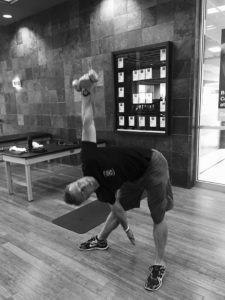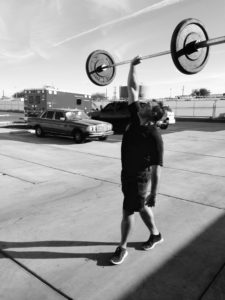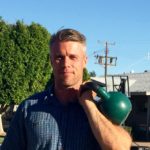Goal #2: – Learn How to Move
Chris Adams
 As I’ve struggled to improve my understanding of movement and training over the years (and there’s still such a long way to go) I’ve noticed an alarming trend. It may be that the trend has always existed and my perception has changed. Maybe a bit of both. Either way, it seems that one of the biggest challenges facing new fire recruits is that they don’t know how to move. I’m not talking about advanced skills here. I’m talking about basic human movement. The stuff we do every day. Many of the recruits that I observe are terrible movers. This trend has seemed to increase in recent years with more and more recruits displaying an inability to move well.
As I’ve struggled to improve my understanding of movement and training over the years (and there’s still such a long way to go) I’ve noticed an alarming trend. It may be that the trend has always existed and my perception has changed. Maybe a bit of both. Either way, it seems that one of the biggest challenges facing new fire recruits is that they don’t know how to move. I’m not talking about advanced skills here. I’m talking about basic human movement. The stuff we do every day. Many of the recruits that I observe are terrible movers. This trend has seemed to increase in recent years with more and more recruits displaying an inability to move well.
“Moving” encompasses two areas: Movement and mobility. In this case, I define movement as the ability to control one’s body in space and apply force to external objects while mobility is the capacity for active range of motion. Mobility is your ease and efficiency of movement.
I’ve discovered a few key areas of movement that are essential to occupational firefighting. I want to note that this list will most certainly change over time. Also keep in mind that all of these movements are intertwined and each affects the other to varying degrees.
Note: This subject is vast. It seems there are endless books, experts, programs and systems to improve movement. Today I’m just going to highlight the common problems that I see affecting fire recruits.
General posture
Your posture is your foundation. It affects mindset, physical function, breathing, and even other people’s perception of you. Moving from a base of poor posture creates a less efficient movement. Repeat this a few thousand times and your setting yourself for overuse and catastrophic injury. Practicing posture takes patience and time but it’s worth the effort.
Thoracic extension
Many people display a chronic, excessive, kyphotic curve (EKC) (think chest caving in and down, shoulders rounded forward and back of the hands facing forward like a gorilla). This is usually a symptom of other postural issues, specifically excessive anterior pelvic tilt. EKC has the potential to contribute to tight shoulders, neck muscles, shoulder injuries and even low back pain and injury.
Lifting and supporting weight overhead – Good shoulder flexion (arms directly overhead), and stability in that position, is a must to maintain healthy shoulders. Especially in an occupation that requires an individual to lift heavy, often unbalance objects overhead repeatedly. It should be noted that shoulder flexion goes hand in hand with poor thoracic extension as the upper back forms the base of support for the shoulders. Make no mistake that with poor shoulder flexion you may still be able to lift and support a weight overhead. However, poor shoulder/back positioning cause compensations which may lead to injury with significant time or load.
Squatting
Squatting is a basic human movement. The practice of deep, full squatting has been lost in the western world. Squatting is a practice that helps maintain hip, knee and ankle mobility and strength. A good squat is essential for sound quadrupedal movement (QM). Good QM is, in turn, essential to fire ground operations. I’m amazed by the frequency of poor squat patterns among fire recruits. Don’t be that guy! Practice unweighted squatting every day and throw weighted squatting in at least once to twice per week.

Hip Hinging: Picking things up off the ground.
This is something you will do during your career over, and over, and over again. Tools, furniture, people, debris and barbells are all examples. Learn how to hinge from the hip correctly activating the posterior chain with a neutral spine. Practice it regularly, even if not practicing heavy. Practice with both legs as well as on one.
Crawling
Crawling or QM is an essential movement to firefighting. As the heat and smoke increase, the firefighter is driven to the floor in order to survive. A firefighter can expect to crawl in full gear weighing more than 70 pounds and possibly have to manipulate hose lines, tools external objects and people. Learn how to best manage each while moving on all fours.
Climbing
For a firefighter basic climbing skills are survival skills. Learn the basics of climbing. You don’t have to learn technical climbing, although it’s a fun skill to learn and develop (I’m a climber so I’m a little biased). Practice tree climbing. Learn basic vaults over walls. Become comfortable with heights. Practice balance on parking blocks, handrails and low walls. Practicing climbing technique can be done safely and without any equipment.
Lunging
Lunging patterns are essential. While we often train leg strength bilaterally (squat variations), Most real life tests of leg strength are unilateral. Running, bounding, single leg jumping, picking up unilateral loads (such as medical boxes) are all practical examples of lunging patterns. Learn and practice lunging in every direction. This will improve leg strength and stability, joint mobility and balance.
In addition to the movements mentioned above you should also be competent with carrying, dragging, pushing (large objects), pulling (weights and objects behind you) and using basic hand and power tools such as the sledge hammer, axe, and power saws.
Efficient movement isn’t just about firefighting. It’s about being an efficient and effective human in your environment. Improving mobility and movement will also go a long way to reduce the chances of injury and pain as you age.
How Do You Improve Your Movement?
Find a Qualified Coach
Your best bet is to find a qualified movement coach. Having an objective eye and competent feedback is invaluable in learning to move well. An experienced individual can also develop a plan of improvement and training. If you don’t have a good coach locally there are several coaches who offer online training.
Take an Honest Assessment
A movement assessment is essential. If you don’t have access to a competent coach then find a way to evaluate your movement. Take video of yourself and compare it to trusted sources. Progress videos are essential to track progress. Often, I’ve found that a person doesn’t realize how much progress they’ve made until they compare one video to the next.
Practice
Movement and mobility can and should be practiced every day. It can be regimented for sets and reps, but doesn’t have to be. Practice moving consciously and find ways to add movement into your routine. Squat for 30 seconds when you have an idle moment. Practice hip hinging mindfully when you pick up your kids, tools, grocery or clean dishes from the dishwasher. Work 10-20 minutes of foam rolling and stretching into your pre-bed routine (something that is great for helping you wind down and sleep better anyway). You’re goal should be to create a habit of daily movement. Use friends and family to keep you honest and on-task.
Focus on One Movement at a Time
I’ve found it most helpful to prioritize one major movement and drill it until you see positive change. It’s easier to maintain focus and keep program compliance when you have a single focus and aren’t overwhelmed.
Have Patience
Improving mobility and movement can take time. Look at it this way. If you’re 30 years old, you’ve been building your bad movement habits for 30 years. It’s going to take more than a couple weeks to improve them. The good news is that with some mindfulness and dedication you can make noticeable changes in much less time than what it took to create the poor habits in the first place. Once you’ve made changes, you’ll find they’re much easier to maintain than build.
Resources:
Stay tuned to Tactical Barbell for Develop a Strong Foundation; Part three in a four part series on training for a career in the fire service.
 Chris Adams is a firefighter/paramedic with 15 years of service to the Salt River Fire Department in the Pima-Maricopa Indian Community. When Chris isn’t reading, learning, or blogging about fitness he enjoys rock climbing, canyoneering, and exploring in the American Southwest.
Chris Adams is a firefighter/paramedic with 15 years of service to the Salt River Fire Department in the Pima-Maricopa Indian Community. When Chris isn’t reading, learning, or blogging about fitness he enjoys rock climbing, canyoneering, and exploring in the American Southwest.
